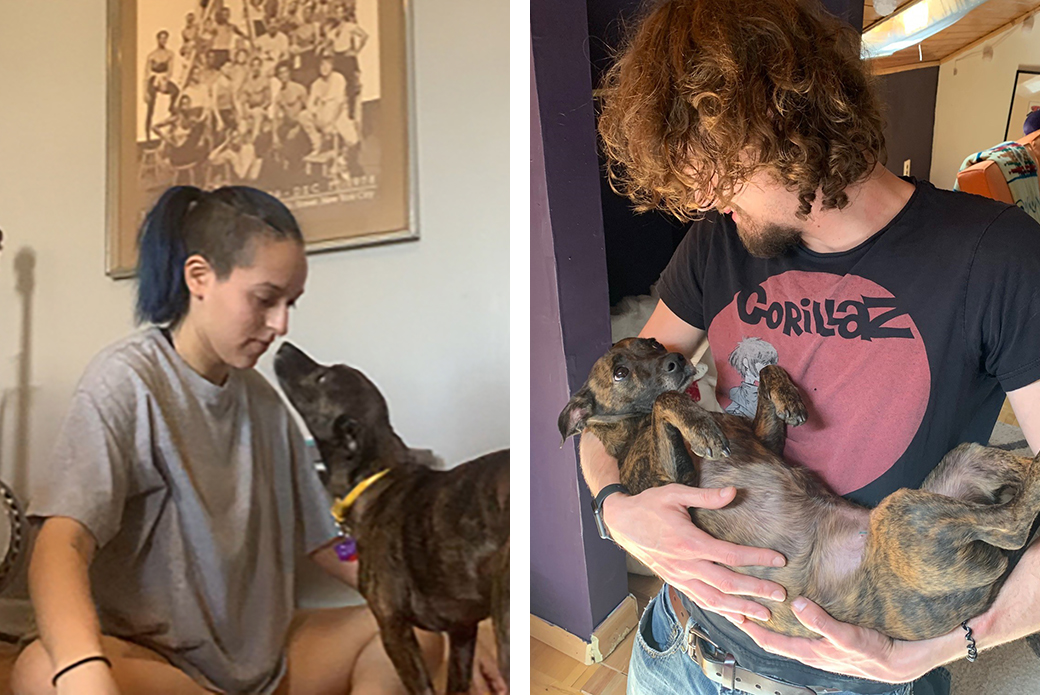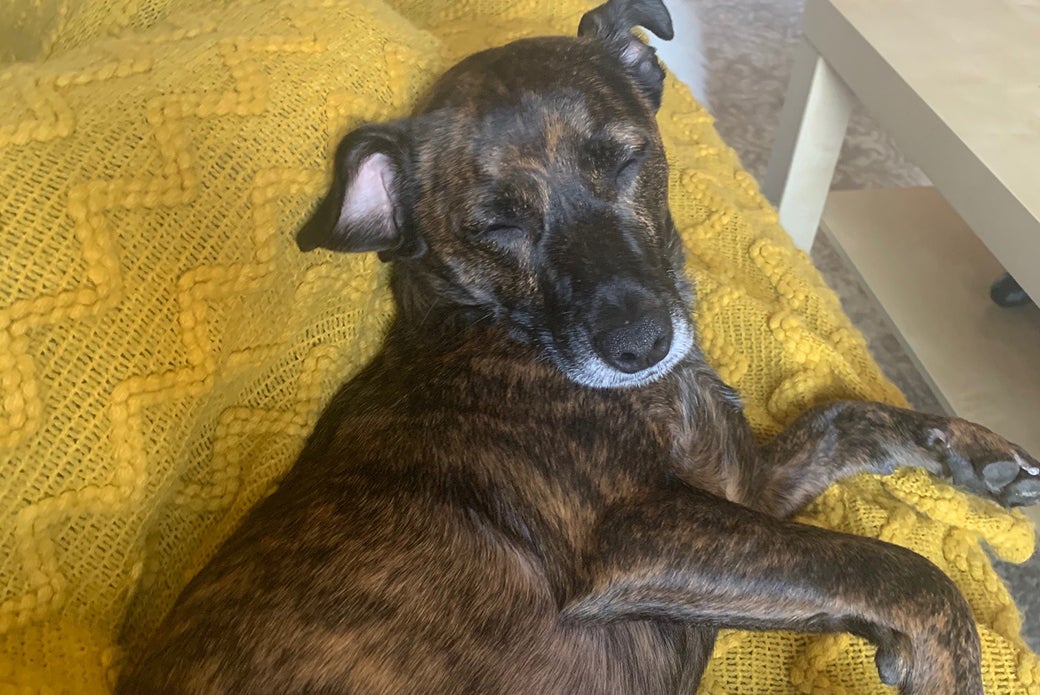

Last December, dancer Kathlenne “Kat” B. and her boyfriend Connor M., a musician, moved to New York City from Orange County, New York to grow their careers. As part of that new chapter in their lives, they also wanted to adopt a dog.
Once the couple rented an apartment on Manhattan’s Upper East Side, they began their search for a pet. One day, while visiting the ASPCA website, they both noticed a 20 lb. brindle pooch named Lady.
“She was this tiny little thing, and we knew we wanted to meet her,” says Kat, who filled out an online application. In late February, she got a phone call from Lady’s foster caretaker who lived just five blocks away.
“She asked if we were still interested in meeting Lady and we were,” says Kat.


When Kat and Connor eventually met Lady, the three clicked right away.
“She seemed okay with us being in her bubble,” says Kat. “We all thought it was a good match.” The couple officially adopted Lady on February 28.
Overcoming Severe Fear
When Lady first arrived at the ASPCA on November 14, 2017, she was just a three-month-old puppy. She was a victim of Hurricane Maria, and had been transported to the U.S. by the ASPCA from St. Croix, where the ASPCA National Field Response team had deployed to assist animals impacted by the storm.


“Originally known as Jess, she was a stray, found with her three brothers and sisters and brought to the ASPCA’s temporary shelter on the island,” recalls Jessica Rushin, ASPCA Director of Placement Partnerships.
Two weeks after her arrival to NYC, Lady was adopted, but unfortunately returned when she turned three years old. She was adopted again in October 2020 but returned again the following January.
“She had real ‘stranger danger,’ and was fearful of people passing by her or cleaning her kennel,” explains Michelle Aragon, a Behavior Specialist who joined the ASPCA in April. “She was my first challenging case regarding fear issues.”


Lady did warm up to a couple of staffers. Erin Caniff, an Animal Care Technician, became her primary handler. The Behavior team joined Erin during her interactions and offered Lady high-value, delicious treats to create a bond with her.
Eventually, Lady approached others for treats and enjoyed petting.
“Once she warmed up to us, I could leash her and take her for walks,” says Michelle, who spent time with Lady daily. “We gradually introduced her to other staff to increase the number of people she interacted with.”
Soon, Lady’s list of handlers grew.
“She reminded me of my dog, Mowgli, who was initially fearful when I adopted him,” says Michelle. “The shelter environment and changes definitely had an impact on Lady. But I saw potential for her to build relationships with people, and even though she is an adult, I could see her puppy-ish personality.”


Lady was eventually placed in a foster home.
“Even though she now had friends in the shelter, we thought she would be happier in a foster home,” adds Rachel Maso, Director of Animal Behavior at the ASPCA Adoption Center. “There, she could comfortably wait for the right adopter.”
A Blueprint for Success
To ensure Lady’s future meet and greets were successful, Michelle collaborated with her colleagues to create a three-pronged plan for introducing Lady to potential adopters.
“Lady’s was a challenging case,” says Rachel. “Our Behavior, Foster and Matchmaking teams—and especially Michelle—worked hard to set her up for success.”


Michelle’s plan started with potential adopters consulting with the Behavior team on the phone or Zoom® to learn about Lady’s behavioral needs and prepare for an in-person meeting. Following that conversation, a virtual meet-and-greet would be scheduled with Lady’s foster, enabling potential adopters to see Lady’s behavior in a home environment. Finally, a carefully curated in-person meeting at the Adoption Center would include a walk with Lady, interaction and further conversation with the Behavior team.
As Michelle spoke with Kat and Connor on the phone, she walked them through the process. When they met Lady in person, they followed Michelle’s instructions “to a tee.”


“Lady didn’t even bark at them, which was unusual,” Michelle says. “And, as we recommended, Kat and Connor didn’t make eye contact with her at first. Everyone did really well.”
A New Opportunity for Opal
Thanks to everyone’s hard work, Lady was set up for better success in her new home with Kat and Connor. She also has a new name to go with her new home: Opal.
“She was a little nervous at first, but we gave her space,” says Kat. “She roamed through our apartment and, by the end of the day, she seemed adjusted and was asking to be pet.”


The couple take Opal for walks frequently.
“Walks are big—they enable her to meet new people,” Kat says. “And we always make sure she has her own safe space. She’s building her confidence and when she walks by people, big dogs and loud children, she keeps her focus on us. Occasionally, she’ll shoot us an ‘Are we good?’ look.”
Both Kat and Connor have had dogs before and are pleased with how far Opal has come.
“She trained us,” Kat says. “She runs up to her leash and taps it with her nose when she needs to go out. She’s very smart.”


Opal likes to be first up the stairs of the couple’s fifth-story, walk-up apartment, and she’s adjusted to the extended family: Kat’s parents as well as Kat’s sister and brother-in-law and their dog, a pit bull mix named Lilo.
Michelle is thrilled that Opal has settled in nicely, and she reuses the three-pronged strategy to successfully find homes for other fearful pets.


“Opal’s success makes me proud of my work and super grateful for the team that made this happen,” says Michelle. “We’re dedicated to finding good homes for pets who need that extra effort to feel safe and loved.”
Source: Read Full Article



